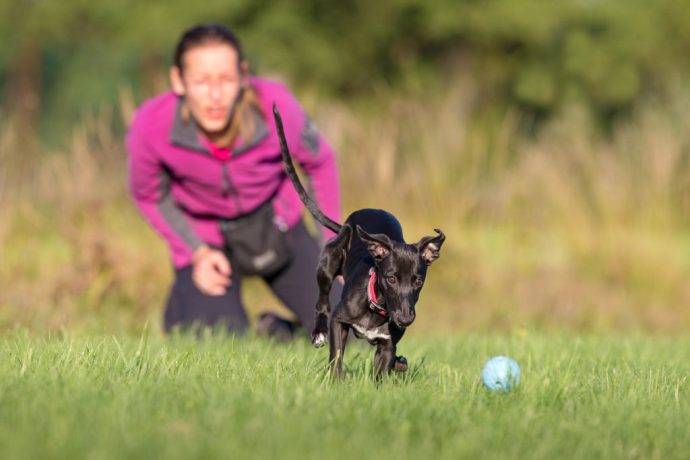A while ago I saw a wonderful collection of 12 photographs by Heike Kain, taken during dog play. She graciously allowed me to share them with you and comment on what I see.
The subjects of photos are 6 year old Whippet Crochett and a 2.5 year old black Galga Espanol Samira (spayed). They have been running around with other dogs, then things quieted down. But Samira wanted to play some more.
Here you can see Samira doing a classic sighthound move: she is cutting Crochett off (though he wasn’t moving anyway as you can see from position of his legs), comes from the side and is trying to make him run, probably so she could chase him.

Crochett does not budge. Only his tail starts lifting. Samira’s eyes are soft. She says she is not a threat.

Samira lands tall on the front feet, daring Crochett to run. Her neck and ears are erect, she’s ready for action, but eyes are still soft. Crochett’s high tail indicates arousal and that he is prepared to take action, even though the rest of his body is completely still.
Samira completes her manouver, waiting for response. Crochett’s response is seen in his tail: he waves it to the left, which can be often seen in dogs who wish to increase distance from the object of their attention. Samira’s maneuver was an intrusion in his personal space that he didn’t appreciate. He doesn’t want to play at this time. He didn’t have to get snarly to get this message across. Just standing still, muscles ready to respond and a left tail wag is all it took.
Look at Crotchett’s tail in the next few photos. He never truly wags to the right.

What happened to Samira’s ears? They were erect and hopeful just two pictures ago. Now she has folded them back, realizing this chase isn’t going to happen. If she would be a pup with bad doggie manners she would jump on Crochett’s back, paw at him or bark. But she read Crochett’s message well and she responds nicely.

She turns her head toward Crotchett with the last glimmer of hope…

Crochett leans away from Samira, indicating that he doesn’t wish to play.

And then also turns his head away to make the message clearer. “I really don’t want to play.”
In response Samira relaxes her neck and tail and turns her head slightly away.
I love these photos because they show how subtle the communication between dogs can be. If we wouldn’t be able to go through pictures again and again we might miss so many things, but Samira and Crochett understood eachother perfectly. Aren’t dogs amazing?
Thank you Heike for sharing these photographs with us!
The fields of behaviorism and ethology study animal behavior. Many dog owners have no idea that we can learn how to read dogs better and unfortunately many people don’t even recognize important emotional states such as fear. I once had to be quite rude to a friend to stop him from trying to pet Ruby (“don’t worry, all dogs love me!”) while Ruby was cowering in fear. Ruby is happy to see him now, but on that first encounter he felt cornered and wanted nothing to do with him.
If you would like to learn more about dog body language, here are some useful links:
Turid Rugaas: Calming signals – The Art of Survival (article)
http://eileenanddogs.com/dog-body-language/ (blog posts)
http://doggonesafe.blogspot.com.au/2012/05/tip-of-day-learn-to-read-dog-body.html (blog post)
Turid Rugaas: On Talking Terms With Dogs: Calming Signals (book and DVD)
Canine Body Language – A Photographic Guide (book)
























